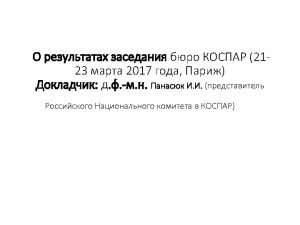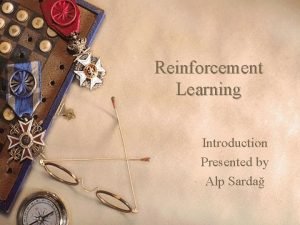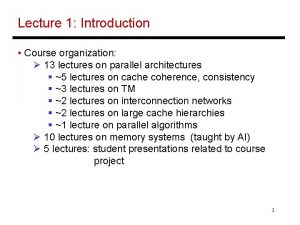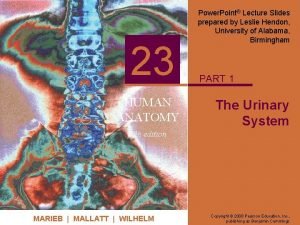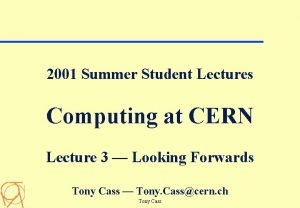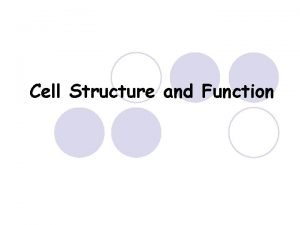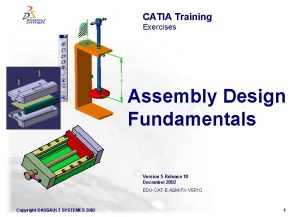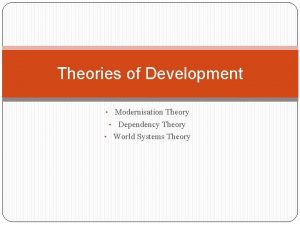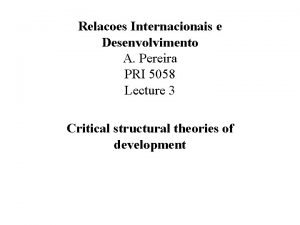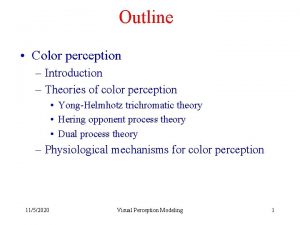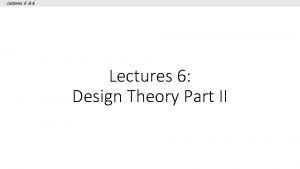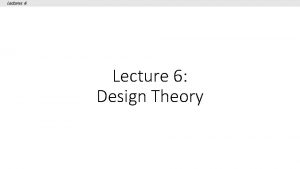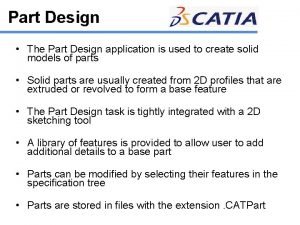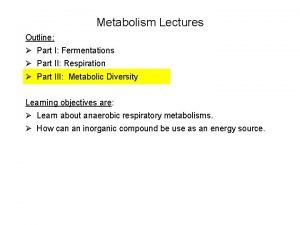Lectures 5 6 Lectures 5 Design Theory Part





































































- Slides: 69

Lectures 5 & 6 Lectures 5: Design Theory Part I

Lecture 5 Today’s Lecture 1. Normal forms & functional dependencies • ACTIVITY: Finding FDs 2. Finding functional dependencies 3. Closures, superkeys & keys • ACTIVITY: The key or a key? 2

Lecture 5 > Section 1 1. Normal forms & functional dependencies 3

Lecture 5 > Section 1 What you will learn about in this section 1. Overview of design theory & normal forms 2. Data anomalies & constraints 3. Functional dependencies 4. ACTIVITY: Finding FDs 4

Lecture 5 > Section 1 > Overview Design Theory • Design theory is about how to represent your data to avoid anomalies. • It is a mostly mechanical process • Tools can carry out routine portions • We have a notebook implementing all algorithms! • We’ll play with it in the activities!

Lecture 5 > Section 1 > Overview Normal Forms • 1 st Normal Form (1 NF) = All tables are flat • 2 nd Normal Form = disused • Boyce-Codd Normal Form (BCNF) • 3 rd Normal Form (3 NF) DB designs based on functional dependencies, intended to prevent data anomalies • 4 th and 5 th Normal Forms = see text books Our focus in this lecture + next one

Lecture 5 > Section 1 > Overview 1 st Normal Form (1 NF) Student Courses Mary {CS 145, CS 229} Joe {CS 145, CS 106} … … Violates 1 NF. Student Mary Joe Courses CS 145 CS 229 CS 145 CS 106 In 1 st NF 1 NF Constraint: Types must be atomic!

Lecture 5 > Section 1 > Data anomalies & constraints Data Anomalies & Constraints

Lecture 5 > Section 1 > Data anomalies & constraints Constraints Prevent (some) Anomalies in the Data A poorly designed database causes anomalies: Student Mary Joe Sam. . Course CS 145. . Room B 01. . If every course is in only one room, contains redundant information!

Lecture 5 > Section 1 > Data anomalies & constraints Constraints Prevent (some) Anomalies in the Data A poorly designed database causes anomalies: Student Mary Joe Sam. . Course CS 145. . Room B 01 C 12 B 01. . If we update the room number for one tuple, we get inconsistent data = an update anomaly

Lecture 5 > Section 1 > Data anomalies & constraints Constraints Prevent (some) Anomalies in the Data A poorly designed database causes anomalies: Student Course Room. . . If everyone drops the class, we lose what room the class is in! = a delete anomaly

Lecture 5 > Section 1 > Data anomalies & constraints Constraints Prevent (some) Anomalies in the Data A poorly designed database causes anomalies: … CS 229 C 12 Student Mary Joe Sam. . Course CS 145. . Room B 01. . Similarly, we can’t reserve a room without students = an insert anomaly

Lecture 5 > Section 1 > Data anomalies & constraints Constraints Prevent (some) Anomalies in the Data Student Mary Joe Sam. . Course CS 145. . Is this form better? Course Room CS 145 B 01 CS 229 C 12 • • Redundancy? Update anomaly? Delete anomaly? Insert anomaly? Today: develop theory to understand why this design may be better and how to find this decomposition…

Lecture 5 > Section 1 > Functional dependencies Functional Dependencies

Lecture 5 > Section 1 > Functional dependencies Functional Dependency Def: Let A, B be sets of attributes We write A B or say A functionally determines B if, for any tuples t 1 and t 2: t 1[A] = t 2[A] implies t 1[B] = t 2[B] and we call A B a functional dependency A->B means that “whenever two tuples agree on A then they agree on B. ”

Lecture 5 > Section 1 > Functional dependencies A Picture Of FDs A 1 … Am B 1 … Bn Defn (again): Given attribute sets A={A 1, …, Am} and B = {B 1, …Bn} in R,

Lecture 5 > Section 1 > Functional dependencies A Picture Of FDs A 1 ti tj … Am B 1 … Bn Defn (again): Given attribute sets A={A 1, …, Am} and B = {B 1, …Bn} in R, The functional dependency A B on R holds if for any ti, tj in R:

Lecture 5 > Section 1 > Functional dependencies A Picture Of FDs A 1 … Am B 1 … Bn Defn (again): Given attribute sets A={A 1, …, Am} and B = {B 1, …Bn} in R, The functional dependency A B on R holds if for any ti, tj in R: ti tj if ti[A 1] = tj[A 1] AND ti[A 2]=tj[A 2] AND … AND ti[Am] = tj[Am] If t 1, t 2 agree here. .

Lecture 5 > Section 1 > Functional dependencies A Picture Of FDs A 1 … Am B 1 … Bn Defn (again): Given attribute sets A={A 1, …, Am} and B = {B 1, …Bn} in R, The functional dependency A B on R holds if for any ti, tj in R: ti tj if ti[A 1] = tj[A 1] AND ti[A 2]=tj[A 2] AND … AND ti[Am] = tj[Am] If t 1, t 2 agree here. . …they also agree here! then ti[B 1] = tj[B 1] AND ti[B 2]=tj[B 2] AND … AND ti[Bn] = tj[Bn]

Lecture 5 > Section 1 > Functional dependencies FDs for Relational Schema Design • High-level idea: why do we care about FDs? 1. Start with some relational schema 2. Find out its functional dependencies (FDs) 3. Use these to design a better schema 1. One which minimizes the possibility of anomalies

Lecture 5 > Section 1 Functional Dependencies as Constraints A functional dependency is a form of constraint • Holds on some instances (but not others) – can check whethere are violations • Part of the schema, helps define a valid instance Recall: an instance of a schema is a multiset of tuples conforming to that schema, i. e. a table Student Mary Joe Sam. . Course CS 145. . Room B 01. . Note: The FD {Course} > {Room} holds on this instance

Lecture 5 > Section 1 Functional Dependencies as Constraints Note that: • You can check if an FD is violated by examining a single instance; • However, you cannot prove that an FD is part of the schema by examining a single instance. • This would require checking every valid instance Student Mary Joe Sam. . Course CS 145. . Room B 01. . However, cannot prove that the FD {Course} -> {Room} is part of the schema

Lecture 5 > Section 1 > Functional dependencies More Examples An FD is a constraint which holds, or does not hold on an instance: Emp. ID E 0045 E 3542 E 1111 E 9999 Name Smith Mike Smith Mary Phone 1234 9876 1234 Position Clerk Salesrep Lawyer 23

Lecture 5 > Section 1 > Functional dependencies More Examples Emp. ID E 0045 E 3542 E 1111 E 9999 Name Smith Mike Smith Mary Phone Position 1234 Clerk 9876 Salesrep 1234 Lawyer {Position} {Phone} 24

Lecture 5 > Section 1 > Functional dependencies More Examples Emp. ID E 0045 E 3542 E 1111 E 9999 Name Smith Mike Smith Mary Phone Position 1234 Clerk 9876 Salesrep 1234 Lawyer but not {Phone} {Position} 25

Lecture 5 > Section 1 > ACTIVITY A B C D E 1 2 4 3 6 3 2 5 1 8 1 4 4 5 7 1 2 4 3 6 3 2 5 1 8 Find at least three FDs which are violated on this instance: { { { } { } } } 26

Lecture 5 > Section 2 2. Finding functional dependencies 27

Lecture 5 > Section 2 What you will learn about in this section 1. “Good” vs. “Bad” FDs: Intuition 2. Finding FDs 3. Closures 4. ACTIVITY: Compute the closures 28

Lecture 5 > Section 2 > Good vs. Bad FDs “Good” vs. “Bad” FDs We can start to develop a notion of good vs. bad FDs: Emp. ID E 0045 E 3542 E 1111 E 9999 Name Smith Mike Smith Mary Phone 1234 9876 1234 Position Clerk Salesrep Lawyer Intuitively: Emp. ID -> Name, Phone, Position is “good FD” • Minimal redundancy, less possibility of anomalies 29

Lecture 5 > Section 2 > Good vs. Bad FDs “Good” vs. “Bad” FDs We can start to develop a notion of good vs. bad FDs: Emp. ID E 0045 E 3542 E 1111 E 9999 Name Smith Mike Smith Mary Phone 1234 9876 1234 Position Clerk Salesrep Lawyer Intuitively: Emp. ID -> Name, Phone, Position is “good FD” But Position -> Phone is a “bad FD” • Redundancy! Possibility of data anomalies 30

Lecture 5 > Section 2 > Good vs. Bad FDs “Good” vs. “Bad” FDs Student Mary Joe Sam. . Course CS 145. . Room B 01. . Returning to our original example… can you see how the “bad FD” {Course} -> {Room} could lead to an: • Update Anomaly • Insert Anomaly • Delete Anomaly • … Given a set of FDs (from user) our goal is to: 1. Find all FDs, and 2. Eliminate the “Bad Ones".

Lecture 5 > Section 2 > Finding FDs for Relational Schema Design • High-level idea: why do we care about FDs? 1. Start with some relational schema 2. Find out its functional dependencies (FDs) 3. Use these to design a better schema 1. One which minimizes possibility of anomalies This part can be tricky!

Lecture 5 > Section 2 > Finding FDs Finding Functional Dependencies • There can be a very large number of FDs… • How to find them all efficiently? • We can’t necessarily show that any FD will hold on all instances… • How to do this? We will start with this problem: Given a set of FDs, F, what other FDs must hold?

Lecture 5 > Section 2 > Finding FDs Finding Functional Dependencies Equivalent to asking: Given a set of FDs, F = {f 1, …fn}, does an FD g hold? Inference problem: How do we decide?

Lecture 5 > Section 2 > Finding FDs Finding Functional Dependencies Example: Products Name Gizmo Widget Gizmo Provided FDs: Color Green Black Green Category Dep Price Gadget Toys 49 Gadget Toys 59 Whatsit Garden 99 1. {Name} {Color} 2. {Category} {Department} 3. {Color, Category} {Price} Given the provided FDs, we can see that {Name, Category} {Price} must also hold on any instance… Which / how many other FDs do? !?

Lecture 5 > Section 2 > Finding FDs Finding Functional Dependencies Equivalent to asking: Given a set of FDs, F = {f 1, …fn}, does an FD g hold? Inference problem: How do we decide? Answer: Three simple rules called Armstrong’s Rules. 1. Split/Combine, 2. Reduction, and 3. Transitivity… ideas by picture

Lecture 5 > Section 2 > Finding FDs 1. Split/Combine A 1 … Am B 1 … A 1, …, Am B 1, …, Bn Bn

Lecture 5 > Section 2 > Finding FDs 1. Split/Combine A 1 … Am B 1 … Bn A 1, …, Am B 1, …, Bn … is equivalent to the following n FDs… A 1, …, Am Bi for i=1, …, n

Lecture 5 > Section 2 > Finding FDs 1. Split/Combine A 1 … Am B 1 … Bn And vice-versa, A 1, …, Am Bi for i=1, …, n … is equivalent to … A 1, …, Am B 1, …, Bn

Lecture 5 > Section 2 > Finding FDs 2. Reduction/Trivial A 1 … Am A 1, …, Am Aj for any j=1, …, m

Lecture 5 > Section 2 > Finding FDs 3. Transitive Closure A 1 … Am B 1 … A 1, …, Am B 1, …, Bn and B 1, …, Bn C 1, …, Ck Bn C 1 … Ck

Lecture 5 > Section 2 > Finding FDs 3. Transitive Closure A 1 … Am B 1 … Bn A 1, …, Am B 1, …, Bn and B 1, …, Bn C 1, …, Ck implies A 1, …, Am C 1, …, Ck C 1 … Ck

Lecture 5 > Section 2 > Finding FDs Finding Functional Dependencies Example: Products Name Gizmo Widget Gizmo Provided FDs: Color Green Black Green Category Dep Price Gadget Toys 49 Gadget Toys 59 Whatsit Garden 99 1. {Name} {Color} 2. {Category} {Department} 3. {Color, Category} {Price} Which / how many other FDs hold?

Lecture 5 > Section 2 > Finding FDs Finding Functional Dependencies Example: Provided FDs: Inferred FDs: Inferred FD Rule used 4. {Name, Category} -> {Name} 5. {Name, Category} -> {Color} 6. {Name, Category} -> {Category} 7. {Name, Category -> {Color, Category} 8. {Name, Category} -> {Price} ? ? ? Which / how many other FDs hold? 1. {Name} {Color} 2. {Category} {Dept. } 3. {Color, Category} {Price}

Lecture 5 > Section 2 > Finding FDs Finding Functional Dependencies Example: Provided FDs: Inferred FDs: Inferred FD Rule used 4. {Name, Category} -> {Name} 5. {Name, Category} -> {Color} 6. {Name, Category} -> {Category} 7. {Name, Category -> {Color, Category} 8. {Name, Category} -> {Price} Trivial Transitive (4 -> 1) Trivial Split/combine (5 + 6) Transitive (7 -> 3) 1. {Name} {Color} 2. {Category} {Dept. } 3. {Color, Category} {Price} Can we find an algorithmic way to do this?

Lecture 5 > Section 2 > Closures

Lecture 5 > Section 2 > Closures Closure of a set of Attributes Given a set of attributes A 1, …, An and a set of FDs F: Then the closure, {A 1, …, An}+ is the set of attributes B s. t. {A 1, …, An} B Example: F = {name} {color} {category} {department} {color, category} {price} Example Closures: {name}+ = {name, color} {name, category}+ = {name, category, color, dept, price} {color}+ = {color} 47

Lecture 5 > Section 2 > Closures Closure Algorithm 48

Lecture 5 > Section 2 > Closures Closure Algorithm {name, category}+ = {name, category} F= {name} {color} {category} {dept} {color, category} {price} 49

Lecture 5 > Section 2 > Closures Closure Algorithm {name, category}+ = {name, category, color} F= {name} {color} {category} {dept} {color, category} {price} 50

Lecture 5 > Section 2 > Closures Closure Algorithm {name, category}+ = {name, category, color} F= {name, category}+ = {name, category, color, dept} {name} {color} {category} {dept} {color, category} {price} 51

Lecture 5 > Section 2 > Closures Closure Algorithm {name, category}+ = {name, category, color} F= {name, category}+ = {name, category, color, dept} {name} {color} {category} {dept} {name, category}+ = {name, category, color, dept, price} {color, category} {price} 52

Lecture 5 > Section 2 > Closures Example R(A, B, C, D, E, F) {A, B} {C} {A, D} {E} {B} {D} {A, F} {B} Compute {A, B}+ = {A, B, } Compute {A, F}+ = {A, F, } 53

Lecture 5 > Section 2 > Closures Example R(A, B, C, D, E, F) {A, B} {C} {A, D} {E} {B} {D} {A, F} {B} Compute {A, B}+ = {A, B, C, D } Compute {A, F}+ = {A, F, B } 54

Lecture 5 > Section 2 > Closures Example R(A, B, C, D, E, F) {A, B} {C} {A, D} {E} {B} {D} {A, F} {B} Compute {A, B}+ = {A, B, C, D, E} Compute {A, F}+ = {A, B, C, D, E, F} 55

Lecture 5 > Section 3 3. Closures, Superkeys & Keys 56

Lecture 5 > Section 3 What you will learn about in this section 1. Closures Pt. II 2. Superkeys & Keys 3. ACTIVITY: The key or a key? 57

Lecture 5 > Section 3 > Closures Pt. II Why Do We Need the Closure? • With closure we can find all FD’s easily • To check if X A 1. Compute X+ 2. Check if A Î X+ Note here that X is a set of attributes, but A is a single attribute. Why does considering FDs of this form suffice? Recall the Split/combine rule: X A 1, …, X An implies X {A 1, …, An} 58

Lecture 5 > Section 3 > Closures Pt. II Using Closure to Infer ALL FDs Step 1: Compute X+, for every set of attributes X: {A}+ = {A} {B}+ = {B, D} {C}+ = {C} {D}+ = {D} {A, B}+ = {A, B, C, D} {A, C}+ = {A, C} {A, D}+ = {A, B, C, D} {A, B, C}+ = {A, B, D}+ = {A, C, D}+ = {A, B, C, D} {B, C, D}+ = {B, C, D} {A, B, C, D}+ = {A, B, C, D} Example: Given F = {A, B} C {A, D} B {B} D No need to compute all of these- why? 59

Lecture 5 > Section 3 > Closures Pt. II Using Closure to Infer ALL FDs Step 1: Compute X+, for every set of attributes X: Example: Given F = {A, B} C {A, D} B {B} D {A}+ = {A}, {B}+ = {B, D}, {C}+ = {C}, {D}+ = {D}, {A, B}+ = {A, B, C, D}, {A, C}+ = {A, C}, {A, D}+ = {A, B, C, D}, {A, B, C}+ = {A, B, D}+ = {A, C, D}+ = {A, B, C, D}, {B, C, D}+ = {B, C, D}, {A, B, C, D}+ = {A, B, C, D} Step 2: Enumerate all FDs X Y, s. t. Y X+ and X Y = : {A, B} {C, D}, {A, D} {B, C}, {A, B, C} {D}, {A, B, D} {C}, {A, C, D} {B} 60

Lecture 5 > Section 3 > Closures Pt. II Using Closure to Infer ALL FDs Step 1: Compute X+, for every set of attributes X: Example: Given F = {A, B} C {A, D} B {B} D {A}+ = {A}, {B}+ = {B, D}, {C}+ = {C}, {D}+ = {D}, {A, B}+ = {A, B, C, D}, {A, C}+ = {A, C}, {A, D}+ = {A, B, C, D}, {A, B, C}+ = {A, B, D}+ = {A, C, D}+ = {A, B, C, D}, {B, C, D}+ = {B, C, D}, {A, B, C, D}+ = {A, B, C, D} Step 2: Enumerate all FDs X Y, s. t. Y X+ and X Y = : {A, B} {C, D}, {A, D} {B, C}, {A, B, C} {D}, {A, B, D} {C}, {A, C, D} {B} “Y is in the closure of X” 61

Lecture 5 > Section 3 > Closures Pt. II Using Closure to Infer ALL FDs Step 1: Compute X+, for every set of attributes X: Example: Given F = {A, B} C {A, D} B {B} D {A}+ = {A}, {B}+ = {B, D}, {C}+ = {C}, {D}+ = {D}, {A, B}+ = {A, B, C, D}, {A, C}+ = {A, C}, {A, D}+ = {A, B, C, D}, {A, B, C}+ = {A, B, D}+ = {A, C, D}+ = {A, B, C, D}, {B, C, D}+ = {B, C, D}, {A, B, C, D}+ = {A, B, C, D} Step 2: Enumerate all FDs X Y, s. t. Y X+ and X Y = : {A, B} {C, D}, {A, D} {B, C}, {A, B, C} {D}, {A, B, D} {C}, {A, C, D} {B} The FD X Y is non-trivial 62

Lecture 5 > Section 3 > Superkeys & Keys Superkeys and Keys

Lecture 5 > Section 3 > Superkeys & Keys and Superkeys A superkey is a set of attributes A 1, …, An s. t. for any other attribute B in R, we have {A 1, …, An} B A key is a minimal superkey i. e. all attributes are functionally determined by a superkey This means that no subset of a key is also a superkey (i. e. , dropping any attribute from the key makes it no longer a superkey)

Lecture 5 > Section 3 > Superkeys & Keys Finding Keys and Superkeys • For each set of attributes X 1. Compute X+ 2. If X+ = set of all attributes then X is a superkey 3. If X is minimal, then it is a key

Lecture 5 > Section 3 > Superkeys & Keys Example of Finding Keys Product(name, price, category, color) {name, category} price {category} color What is a key?

Lecture 5 > Section 3 > Superkeys & Keys Example of Keys Product(name, price, category, color) {name, category} price {category} color

Lecture 5 > Section 3 > ACTIVITY Activity-5 -1. ipynb 68

Lectures 5, 7 > SUMMARY Summary • Constraints allow one to reason about redundancy in the data • Normal forms describe how to remove this redundancy by decomposing relations • Elegant—by representing data appropriately certain errors are essentially impossible • For FDs is the normal form.
 Theory of translation lectures
Theory of translation lectures What is text linguistics
What is text linguistics Theory of translation lectures
Theory of translation lectures Theory of translation lectures
Theory of translation lectures Digital logic design lectures
Digital logic design lectures Rick trebino lectures
Rick trebino lectures Neonatology lectures
Neonatology lectures Data mining lectures
Data mining lectures Medicinal chemistry lectures
Medicinal chemistry lectures Orthopedic ppt lectures
Orthopedic ppt lectures Cs614 short lectures
Cs614 short lectures Software project management lectures
Software project management lectures Molecular biology lectures
Molecular biology lectures Radio astronomy lectures
Radio astronomy lectures Dr sohail lectures
Dr sohail lectures Utilities and energy lecture
Utilities and energy lecture Web engineering lectures ppt
Web engineering lectures ppt Do words have power
Do words have power Frcr physics lectures
Frcr physics lectures Frcr physics lectures
Frcr physics lectures Introduction to recursion
Introduction to recursion Guyton physiology lectures
Guyton physiology lectures Aerodynamics lecture
Aerodynamics lecture Power system lectures
Power system lectures Kurose ross computer networking
Kurose ross computer networking Hegel three forms of art
Hegel three forms of art Nuclear medicine lectures
Nuclear medicine lectures Recursive fractals c++
Recursive fractals c++ Cdeep lectures
Cdeep lectures Oral communication 3 lectures text
Oral communication 3 lectures text C programming and numerical analysis an introduction
C programming and numerical analysis an introduction Haematology lectures
Haematology lectures Bureau of lectures
Bureau of lectures Slagle lecture
Slagle lecture Reinforcement learning lectures
Reinforcement learning lectures 13 lectures
13 lectures Reinforcement learning lectures
Reinforcement learning lectures Bba lectures
Bba lectures Medical emergency student lectures
Medical emergency student lectures Hematology lectures for medical student
Hematology lectures for medical student Rcog cpd portfolio
Rcog cpd portfolio Bhadeshia lectures
Bhadeshia lectures Yelena bogdan md
Yelena bogdan md Comsats virtual campus lectures
Comsats virtual campus lectures Hugh blair lectures on rhetoric
Hugh blair lectures on rhetoric Cern summer student lectures
Cern summer student lectures Pathology lectures for medical students
Pathology lectures for medical students Dr asim lectures
Dr asim lectures Ota core curriculum
Ota core curriculum Anatomy lectures powerpoint
Anatomy lectures powerpoint Cern summer school lectures
Cern summer school lectures Part whole model subtraction
Part whole model subtraction Unit ratio definition
Unit ratio definition Brainpop ratios
Brainpop ratios What is a technical description?
What is a technical description? Describe the parts of a front bar?
Describe the parts of a front bar? The phase of the moon you see depends on ______.
The phase of the moon you see depends on ______. Minitab adalah
Minitab adalah Rough endoplasmic reticulum function
Rough endoplasmic reticulum function Theory of recovery the withdrawal of status
Theory of recovery the withdrawal of status Wireframe and surface design
Wireframe and surface design Catia v5 assembly design exercises
Catia v5 assembly design exercises Trait theory of leadership
Trait theory of leadership Continental drift
Continental drift Wallerstein's world systems theory
Wallerstein's world systems theory Opponent process theory vs trichromatic theory
Opponent process theory vs trichromatic theory Modernization theory vs dependency theory
Modernization theory vs dependency theory Continental drift vs plate tectonics theory
Continental drift vs plate tectonics theory Describe the trichromatic theory of color vision.
Describe the trichromatic theory of color vision. Neo classical organizational theory
Neo classical organizational theory
































